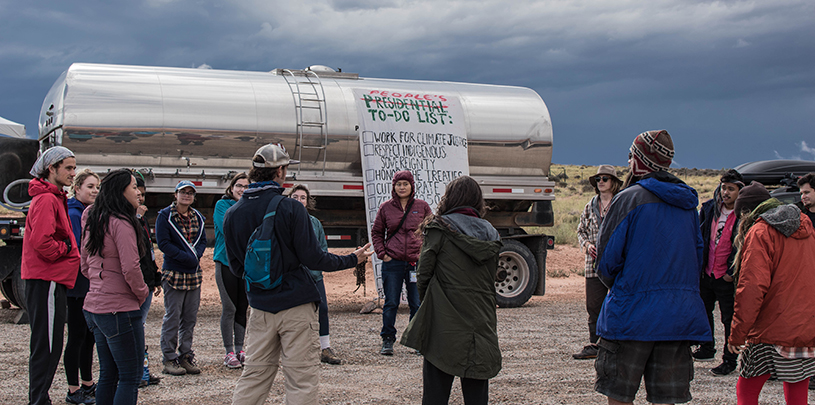
 by Eva Malis, Uplift Coordinator
by Eva Malis, Uplift Coordinator
Under a dark September sky, a group of millennials stood in a large circle, singing with people they had just met for the first time:
“The people gonna rise like the water,
Gonna calm this crisis down.
I hear the voice of my great granddaughter,
Singing ‘Climate justice now.’”
A banner, reading “Presidential PEOPLE’S TO-DO LIST,” flapped in the wind. We had all traveled from distant corners of the country to a group campsite outside of Moab, Utah to talk climate justice on the Colorado Plateau.
This fall, about 150 young activists attended our third annual Uplift Climate Conference, where we shared stories of climate activism — struggles against uranium mines, fracking rigs, and power plants that exploit our beloved homelands and threaten the health of our communities.

A stark expanse of red rock boldly framed the speakers and stage. Hues of blue, purple, and red sandstone stretched from our high desert campground all the way to the La Sal Mountains in the distance, a beautiful and relevant backdrop for our conversations about protecting public lands.
Almost out of sight, to the northeast, we could just barely see the outline of the Tavaputs Plateau, where tar sands and fracking developments haunt the landscape. To the south, the White Mesa Uranium Mill and the threatened Bears Ears National Monument were hidden from view but present in our minds. Holding these conversations on our open public lands served as a constant reminder of what’s at stake.
“The Colorado Plateau is a sacrifice zone for energy infrastructure,” explained Brooke Larsen, a 25-year-old activist from Salt Lake City whose family has lived in this region for generations. Her comment echoed a similar sentiment expressed earlier that morning by Diné community activist Kendra Pinto: “They care more about what’s under the ground than who lives on top of it.”
Sometimes, it takes an idea, a story, or a person to move you toward action, to remind you what you’re fighting for. That’s why these in-person gatherings are so important — to move us.
“It’s not important what you’re doing, but why you’re doing it,” our keynote speaker Janene Yazzie reminded us that cold Friday night. She invited the crowd of Uplifters to lean over and touch the ground we were sitting on, close our eyes, and revisit the relationship between the living and the land. With sand beneath our fingertips, we were reminded of our stake in the fight for climate justice.
I felt moved by each person that I met at Uplift. Take Zefren Anderson, for example, a young fiber artist working towards climate justice by practicing traditional Navajo weaving. Or Michaela Mujica-Steiner, a 23-year-old who has been resisting fracking in her community in Colorado for years. I watched in amazement as, within hours, deep friendships formed between Uplifters from vastly different communities. I saw how easily passion can unite people, how readily our hearts can absorb lessons from each other, and how story can always relate us. It was as if we were all there to share a message with one another: don’t give up on the fight, because I am here to fight with you.
When I hear the word “conference”, I think of sitting in an auditorium in business-casual clothes, impatiently checking my phone to avoid small talk, or exchanging business cards over forced laughter. But at Uplift, rooted in the red rock, we re-grounded ourselves in the true possibility of a gathering: the opportunity to open our hearts fully and vulnerably to strangers, and to be received with the power of community.

In 2017, we are drawing ever closer to the deadline of avoiding worst-case scenarios of climate disaster. As a 22-year-old, I carry the weight of my generation’s climate anxiety. But, I don’t carry it alone. At Uplift, we learned that our struggles are all connected — and we were reminded that there is a movement all around us, much bigger than ourselves. Together, we will bring about the change that we believe in.
Did you know the Colorado River used to be called the Grand River? Learn about the name change and more fun facts about this hardworking river.
Read MoreChallenging conditions have endangered, threatened, or imperiled these five native fish in the Grand Canyon.
Read MoreBeneath the bathtub ring at Lake Powell, native plants are flourishing, cultural sites are resurfacing, and whitewater rapids are returning.
Read More